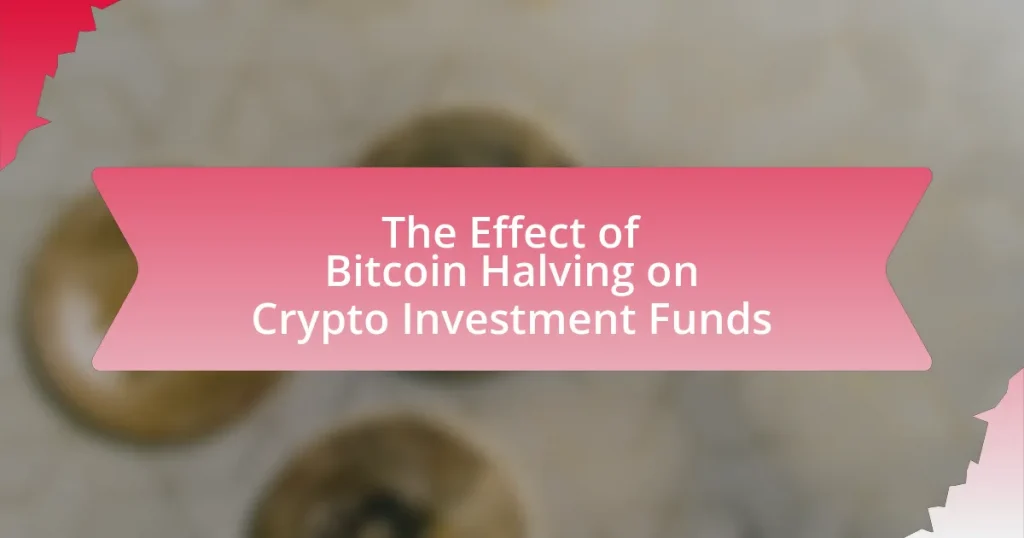The main entity of the article is Bitcoin Halving, an event that occurs approximately every four years, reducing the reward for mining new blocks by half. This mechanism is crucial as it controls Bitcoin’s supply, creating scarcity that can influence its price and investment strategies in crypto funds. The article examines the historical significance of Bitcoin Halving, its impact on supply dynamics, and how it affects miners and investors. It also explores the correlation between past halving events and price increases, the strategies employed by crypto investment funds in response to these events, and the potential risks and rewards associated with investing around halving periods.

What is the Bitcoin Halving and its significance?
The Bitcoin Halving is an event that occurs approximately every four years, reducing the reward for mining new blocks by half. This mechanism is significant because it controls the supply of Bitcoin, creating scarcity and potentially influencing its price. Historically, past halvings in 2012, 2016, and 2020 have been followed by substantial price increases, indicating a correlation between halving events and market behavior. The reduction in new Bitcoin supply can lead to increased demand, thereby impacting investment strategies in crypto funds.
How does Bitcoin Halving impact the supply of Bitcoin?
Bitcoin Halving reduces the rate at which new Bitcoins are created, directly impacting the supply of Bitcoin. Specifically, the halving event occurs approximately every four years, cutting the block reward miners receive for validating transactions in half. For instance, the initial reward was 50 Bitcoins per block, which decreased to 25 in 2012, then to 12.5 in 2016, and further to 6.25 in 2020. This reduction in new supply creates scarcity, as the total supply of Bitcoin is capped at 21 million coins, leading to potential upward pressure on price due to increased demand against a diminishing supply. Historical data shows that past halving events have often preceded significant price increases, reinforcing the correlation between halving and supply dynamics.
What mechanisms govern the Bitcoin Halving process?
The Bitcoin Halving process is governed by a predetermined algorithm within the Bitcoin protocol that reduces the block reward miners receive for validating transactions by half approximately every four years. This mechanism is designed to control the supply of Bitcoin, ensuring that only 21 million Bitcoins will ever be mined, which creates scarcity and can influence market dynamics. The halving occurs every 210,000 blocks, and historical data shows that past halvings in 2012, 2016, and 2020 have led to significant price increases in the months following the event, reinforcing the relationship between halving and market behavior.
How does the reduction in block rewards affect miners?
The reduction in block rewards negatively impacts miners by decreasing their revenue from mining activities. As block rewards are halved, miners receive fewer bitcoins for the same amount of computational work, which can lead to reduced profitability. For instance, after the Bitcoin halving events in 2012, 2016, and 2020, miners experienced a significant drop in the number of bitcoins earned per block, which necessitated increased efficiency or higher bitcoin prices to maintain profitability. This economic pressure can lead to some miners exiting the market, particularly those with higher operational costs, thereby affecting the overall network’s security and transaction processing capabilities.
Why is Bitcoin Halving important for investors?
Bitcoin Halving is important for investors because it reduces the rate at which new bitcoins are created, effectively decreasing supply while demand may remain constant or increase. This mechanism, occurring approximately every four years, historically leads to price appreciation due to the scarcity effect; for instance, after the halving events in 2012, 2016, and 2020, Bitcoin’s price saw significant increases in the following months and years. The reduction in supply can create upward pressure on prices, making it a critical event for investors to consider when strategizing their investments in the cryptocurrency market.
What historical trends have emerged from past halvings?
Historical trends from past Bitcoin halvings indicate a pattern of significant price increases following each event. For instance, after the first halving in November 2012, Bitcoin’s price rose from approximately $12 to over $1,100 within a year. Similarly, following the second halving in July 2016, the price surged from around $650 to nearly $20,000 by December 2017. The most recent halving in May 2020 saw Bitcoin’s price increase from about $8,500 to an all-time high of over $64,000 by April 2021. These trends suggest that halvings often lead to bullish market conditions, driven by reduced supply and increased demand.
How does market sentiment shift around halving events?
Market sentiment typically becomes bullish around halving events, as historical data shows increased interest and speculation in Bitcoin. For instance, the halving events in 2012, 2016, and 2020 were followed by significant price increases, with Bitcoin’s price rising approximately 8,000% after the 2012 halving and around 1,000% after the 2016 halving. This pattern indicates that investors often anticipate reduced supply and potential price appreciation, leading to heightened optimism and buying activity in the market.

How does Bitcoin Halving influence Crypto Investment Funds?
Bitcoin Halving significantly influences Crypto Investment Funds by reducing the rate at which new bitcoins are created, thereby impacting supply and potentially driving up prices. Historically, after each halving event, such as those in 2012, 2016, and 2020, Bitcoin’s price has experienced substantial increases, which in turn attracts more institutional and retail investors to crypto investment funds. For instance, following the 2020 halving, Bitcoin’s price surged from around $8,000 to over $60,000 within a year, leading to increased inflows into investment funds focused on cryptocurrencies. This correlation between halving events and price appreciation creates a favorable environment for investment funds, as they often capitalize on the heightened market interest and potential for profit.
What changes occur in investment strategies post-halving?
Post-halving, investment strategies typically shift towards increased accumulation of Bitcoin due to anticipated price appreciation. Historical data shows that after previous halvings in 2012 and 2016, Bitcoin’s price experienced significant upward trends, leading investors to adopt a long-term holding strategy. For instance, after the 2016 halving, Bitcoin’s price surged from around $650 to nearly $20,000 within a year. This historical precedent influences current investors to adjust their strategies by focusing on dollar-cost averaging and reducing short-term trading activities, as they expect a similar bullish trend following the halving event.
How do fund managers adjust their portfolios in response to halving?
Fund managers adjust their portfolios in response to halving by reallocating assets to capitalize on anticipated price increases in Bitcoin. Historical data shows that following previous halvings, Bitcoin’s price has often surged, prompting fund managers to increase their Bitcoin holdings or invest in related cryptocurrencies to maximize returns. For instance, after the 2016 halving, Bitcoin’s price rose from around $450 to nearly $20,000 within a year, influencing fund managers to adopt a bullish stance on Bitcoin and related assets. This strategic adjustment is based on the expectation that reduced supply will lead to higher demand, thus driving prices upward.
What role does Bitcoin’s price volatility play in fund performance?
Bitcoin’s price volatility significantly impacts fund performance by influencing risk assessment and investment strategies. High volatility can lead to substantial gains or losses, affecting the overall returns of funds that include Bitcoin in their portfolios. For instance, during periods of extreme price fluctuations, funds may experience increased drawdowns, which can deter risk-averse investors. Conversely, volatility can also present opportunities for active trading strategies, allowing funds to capitalize on price swings. Historical data shows that Bitcoin’s price has experienced fluctuations exceeding 20% within short time frames, underscoring the potential for both risk and reward in fund performance linked to Bitcoin investments.
How do Crypto Investment Funds react to market predictions surrounding halving?
Crypto investment funds typically react to market predictions surrounding halving by adjusting their investment strategies and portfolio allocations. Historical data shows that prior to halving events, such as the 2012, 2016, and 2020 halvings, funds often increase their exposure to Bitcoin, anticipating price appreciation due to reduced supply. For instance, in the months leading up to the 2020 halving, Bitcoin’s price surged from around $7,000 to over $10,000, reflecting increased investor interest and speculation. This pattern indicates that funds leverage market predictions to capitalize on potential price movements, often leading to increased buying activity as the halving date approaches.
What indicators do funds use to forecast Bitcoin price movements?
Funds use a variety of indicators to forecast Bitcoin price movements, including technical analysis metrics, market sentiment, and on-chain data. Technical analysis often involves the use of moving averages, Relative Strength Index (RSI), and Bollinger Bands to identify trends and potential reversal points. Market sentiment is gauged through metrics like the Fear and Greed Index, which reflects investor emotions and can signal potential price movements. On-chain data, such as transaction volume and wallet activity, provides insights into the actual usage and demand for Bitcoin, further informing price predictions. These indicators collectively help funds make informed investment decisions based on historical patterns and current market conditions.
How do investor behaviors shift in anticipation of halving events?
Investor behaviors shift towards increased buying activity in anticipation of halving events. Historical data shows that prior to each Bitcoin halving, such as in 2012, 2016, and 2020, there was a notable surge in investor interest and market speculation, often leading to price increases. For instance, in the months leading up to the 2020 halving, Bitcoin’s price rose from approximately $7,000 to over $10,000, reflecting heightened investor confidence and accumulation strategies. This pattern indicates that investors tend to position themselves for potential future gains, driven by the expectation of reduced supply and increased scarcity following halving events.

What are the potential risks and rewards for Crypto Investment Funds during halving?
Crypto Investment Funds face both significant risks and rewards during Bitcoin halving events. The primary reward is the potential for increased asset value, as historical data shows that Bitcoin’s price often rises in the months following a halving due to reduced supply and heightened demand; for instance, after the 2020 halving, Bitcoin’s price surged from around $8,700 to over $60,000 within a year. Conversely, the risks include market volatility and the possibility of a price correction, as speculative trading can lead to sharp declines; for example, after the 2017 halving, Bitcoin experienced a significant drop from its all-time high shortly thereafter. Thus, while halving can create opportunities for profit, it also introduces uncertainty that can adversely affect investment funds.
What risks do funds face during Bitcoin Halving periods?
Funds face significant risks during Bitcoin Halving periods, primarily due to increased volatility and market speculation. Historical data shows that Bitcoin’s price often experiences sharp fluctuations around halving events, as seen in the 2012, 2016, and 2020 halvings, where prices surged and subsequently corrected. This volatility can lead to substantial losses for funds that are unable to manage their positions effectively. Additionally, the anticipation of reduced supply can trigger speculative trading, resulting in price bubbles that may burst, further exposing funds to financial risk. The uncertainty surrounding market reactions to halving events can complicate investment strategies, making it challenging for funds to maintain stable returns.
How can market corrections impact fund valuations?
Market corrections can significantly reduce fund valuations by decreasing the prices of underlying assets. During a market correction, investor sentiment often shifts negatively, leading to widespread selling and a decline in asset prices, which directly impacts the net asset value (NAV) of investment funds. For instance, during the 2020 market correction caused by the COVID-19 pandemic, many equity funds experienced declines of 30% or more, reflecting the rapid drop in stock prices. This correlation between market corrections and fund valuations is evident as funds holding volatile assets, such as cryptocurrencies, can see even sharper declines, further illustrating the sensitivity of fund valuations to market fluctuations.
What are the implications of regulatory changes during halving events?
Regulatory changes during halving events can significantly impact market dynamics and investor behavior in the cryptocurrency sector. For instance, when regulations become more stringent, they may lead to increased volatility as investors react to potential risks associated with compliance and market access. Historical data from previous halving events, such as the 2016 and 2020 halvings, show that regulatory announcements often coincide with price fluctuations, indicating that market participants closely monitor regulatory developments. Additionally, favorable regulatory changes can enhance institutional investment, as seen in 2020 when clearer regulations in various jurisdictions encouraged more funds to enter the market, thereby amplifying the effects of the halving on price appreciation.
What strategies can funds employ to maximize returns during halving?
Funds can maximize returns during Bitcoin halving by implementing strategies such as accumulating Bitcoin before the halving event, utilizing options trading to hedge against volatility, and diversifying their portfolios with altcoins that historically benefit from Bitcoin’s price movements. Accumulating Bitcoin prior to halving is based on historical trends, where past halvings have led to significant price increases in the months following the event, as seen in 2012 and 2016 when Bitcoin’s price surged substantially post-halving. Options trading allows funds to manage risk and capitalize on price fluctuations, providing a safety net against potential downturns. Additionally, diversifying into altcoins can capture gains from the overall market uplift that often accompanies Bitcoin’s price rise, as evidenced by the correlation between Bitcoin’s performance and altcoin rallies during previous halving cycles.
How can diversification mitigate risks associated with halving?
Diversification can mitigate risks associated with halving by spreading investments across various cryptocurrencies and asset classes, reducing the impact of Bitcoin’s price volatility. When Bitcoin undergoes halving, its supply decreases, often leading to price fluctuations that can adversely affect investors. By holding a mix of assets, such as altcoins, stablecoins, and traditional investments, investors can cushion against potential losses from Bitcoin’s performance. Historical data shows that during previous halvings, while Bitcoin experienced significant price changes, other cryptocurrencies sometimes moved independently, providing alternative growth opportunities. This strategy allows investors to balance their portfolios and minimize the overall risk during periods of uncertainty linked to Bitcoin halving events.
What best practices should funds follow to capitalize on halving trends?
Funds should adopt a proactive investment strategy that includes accumulating Bitcoin prior to the halving event and diversifying their portfolios to mitigate risks. Historical data shows that Bitcoin’s price typically experiences significant appreciation in the months leading up to and following halving events, as seen in the 2012, 2016, and 2020 halvings, where prices surged by over 800%, 1,000%, and 300% respectively in the year following each event. Additionally, funds should implement risk management techniques, such as setting stop-loss orders and regularly rebalancing their portfolios, to protect against market volatility that often accompanies these trends.
What should investors consider when investing in Crypto Investment Funds around halving?
Investors should consider the historical price trends and market volatility associated with Bitcoin halving events when investing in Crypto Investment Funds. Historically, Bitcoin halving has led to significant price increases in the months following the event, as seen in 2012 and 2016, where Bitcoin’s price surged by over 800% and 1,500%, respectively, within a year after each halving. Additionally, investors should evaluate the fund’s exposure to Bitcoin and its strategy for managing volatility, as halving can create speculative trading behavior that impacts fund performance. Understanding the timing of the halving and its potential effects on supply and demand dynamics is crucial for making informed investment decisions.















